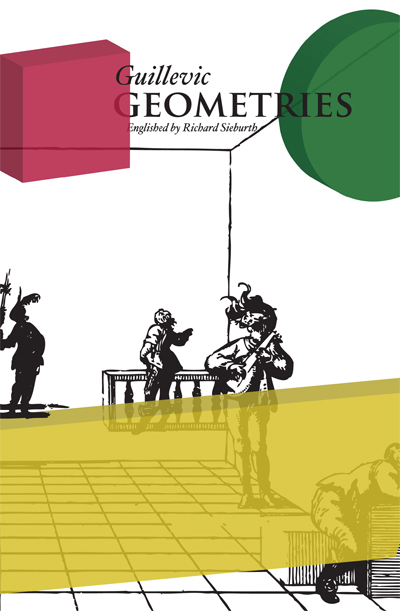from Geometries (click to enlarge):

Who knew a poet could wrestle such sexy moves from old Euclid's boxy shapes!
Pierre Joris
Guillevic wrote Geometries (Euclidiennes in French) in the early sixties, encouraged by his friend, the poet André Frenaud, who recognized in his poetry an inclination toward mathematics, and more specifically geometry. Guillevic places a series of geometrical figures before our eyes, as they might appear in a schoolchild’s primer, paired with poems that let us hear how these forms might speak. These talking circles, squares and angles—these articulations of space—are in turn meant to remind us of our own figures of speech. Guillevic’s Geometries fits into the 1960s return to emblems, signs, and playful constraints both in art (Robert Indiana, Jasper Johns, Robert Rauschenberg and even Andy Warhol) and in writing (the Noigandres poets, Oulipo, Eugen Gomringer, the Robert Creeley of Pieces). But at the same time, the Euclidean world of forms here explored remains as timeless as the stones of Guillevic’s own Carnac.
Born in 1907 in Carnac in Brittany, Eugene Guillevic began writing poetry as a child at school, where he encountered Jean La Fontaine’s fables, learning many of them by heart (an experience that would influence much of Guillevic’s poetry). After completing his Baccalaureate in Mathematics, Guillevic went on to serve as Inspecteur d’Economie Nationale for the Ministry of France. His career, with its legal and managerial demands, had a significant and firm effect on his poetry, which moves away from the Surrealist “obsession” with the Image, and toward the clarity of the Object. Guillevic received Le Grand Prix de Poésie from the French Academy in 1976 and Le Grand Prix National de Poésie in 1984.
Such delight! Who knew a poet could wrestle such sexy moves from old Euclid's boxy shapes! That a French poet did so doesn't come as much of a surprise, Guillevic being a master of small, perfectly crafted camées. Now admirably Englished by Richard Sieburth these gems have kept all their Gallic lightness and grace—that's a true achievement.
Pierre Joris
Geometries manages to combine abstract emotions with abstract theoretical mathematics and into a slim book of universal insight, forcing one to reconsider the greater good that math and poetry can achieve. It does so with charm and poise, making this dance between lyric and figure seem effortless. Love and an x/y axis were never more compatible.
BOMBLOG
Sieburth stealthily draws the poems down that line into a wonderfully pleasing feeling that something true has been discovered in the oddest of ways.
Jennifer Kronovet
Geometries revels in the simplicity of structure, but knows that each profile has its own language.
Make Magazine
a sparkling new translation of Guillevic’s masterpiece
ArchNewsNow.com
Richard Sieburth’s translations include Friedrich Holderlin’s Hymns and Fragments, Walter Benjamin’s Moscow Diary, Nerval’s Selected Writings, Henri Michaux’s Emergences/Resurgences, Michel Leiris’ Nights as Day, Days as Night, and Gershom Sholem’s poetry. His English edition of the Nerval won the 2000 PEN/Book-of-the-Month-Club Translation Prize. His translation of Maurice Scève’s Délie was a finalist for the PEN Translation Prize and the Weidenfeld Prize. He is most recently the translator of Gérard de Nerval's The Salt Smugglers (Archipelago Books, 2009).
ISBN: 978-1-933254-72-2
Trade Paperback
Perfect-bound. 80 pp, 5.25 x 8 in
Publication Date: June 01 2010
Distribution: SPD
Series: Lost Literature #9